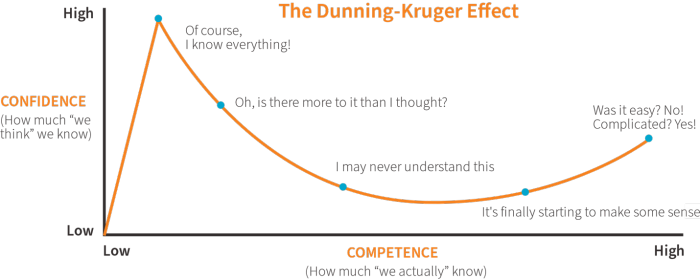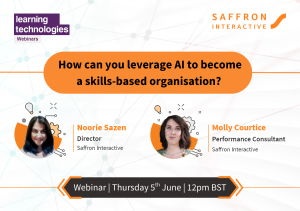Developing learners who are confident in their own ability; that’s got to be a positive thing, right? Not necessarily. Overinflated or misplaced confidence is often one potential blocker in achieving a workforce that is ready and prepared to cope with the unknown future of work.
Adaptability, resilience, growth
If the current uncertain employment landscape has taught us anything – it is that our workforces need to be prepared to cope with any problem or road block they may come up against.
At Saffron, we have been exploring for quite some time, how to build a workforce that embodies the key principles of heutagogy or ‘self-determination’. Those who achieve this elusive goal are the people who will be able to cope with the fast-paced working landscape of the future. This requires adaptability and resilience, alongside the ability to synthesise knowledge (rather than purely receive it). It’s this that is the driving force for business stability, as well as continuous growth.
Don’t lose your learners
So, if you put the mechanisms in place and achieve a workforce who can drive their own learning and development, then you’re done and dusted? Not quite. Whilst heutagogy could be the solution to many of your organisation’s upskilling woes, these types of learners are often very susceptible to becoming ‘siloed‘ and losing perspective on their own development or true capability. Meaning that they may view themselves as fully competent or capable in a particular skill and therefore unwilling to listen to outside feedback that may say otherwise, either from their peers or line managers.

This potential loss of perspective is where the risk to organisational growth lies. Learners who are unaware of or unable to identify their developmental needs and act upon them, are likely to remain stagnant. This can lead to a deficit within your business innovation and growth prospects – if your workforce isn’t advancing, neither can your organisation. But by combatting this issue head on, and utilising your learning interventions to do so, you can seamlessly accelerate the acquisition of key skills and drive continuous learning.
Long and winding road
Even for the most experienced learner, the journey from novice through to competence and to eventually achieving true capability is long, and learners are often unable to offer unbiased insight into their own capability. This notion was conceptualised by two psychologists Dunning and Kruger, in their 1999 research rather charmingly titled; ‘Unskilled and Unaware of It: How Difficulties in Recognizing One’s Own Incompetence Lead to Inflated Self-Assessments’. Dunning and Kruger theorised that when an individual’s competence is at its lowest, their confidence is at its highest – because they don’t know enough to truly understand how little they know. And it’s that gap between perceived knowledge and actual knowledge that prevents individuals from catching their own errors – leading to overconfidence and skewed self-perception.

But it’s essential to view that gap as a positive! Its very existence offers your learners an opportunity to further their own development. The key is harnessing and highlighting that gap in ways that will motivate rather than alienate your learners and avoid pushing them further into siloed behaviours.
Mirror, mirror on the wall
Successfully navigating feedback and its impacts can be a minefield for people managers – but giving your learners the opportunity to step back and objectively view their own skill gaps can be a powerful tool in targeting and accelerating development in key areas.
As we’ve already explored, humans have an inherent ability to self-assess inaccurately. But that shouldn’t prevent us from offering learners the opportunity to do it within learning interventions. Self-reflection is a skill, like any other, and the more we do it the better we get.

By weaving evaluation throughout learning, especially in simulations, we can build a picture of true learner capability. By offering strategic points for self-assessment and reflection, and displaying the results of the simulation alongside their self-evaluation, we can ‘hold a mirror up’ to the learner. Doing this offers the opportunity to discover key areas for improvement, therefore tailoring their progression and accelerating development of key skills – as well as avoiding learner alienation due to the impact of negative feedback.
Once the mirror has been put up, it is vital that mechanisms are then in place to support the learner on their next steps. This means providing them with resources or further learning needed to tackle the areas identified and avoid the learner getting lost in the learning jungle. Alongside this, there also needs to be support mechanisms in place to facilitate subsequent mentor or line manager conversations if the results or disparities highlighted in the evaluation may not have been as expected.
Creating purpose-built learning that enables seamless learner development and encourages self-determination within your workforce can seem quite daunting. But working with the right learning partner and harnessing the plethora of data you’ve got at your fingertips, you can be up and running before you know it.
Reach out to one of our Saffron learning consultants and we can explore how utilising your learners self-reflection can be a powerful tool for your organisation’s future growth!




